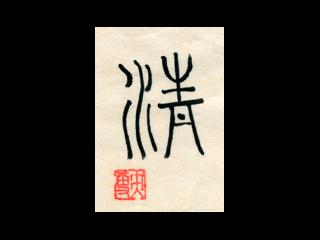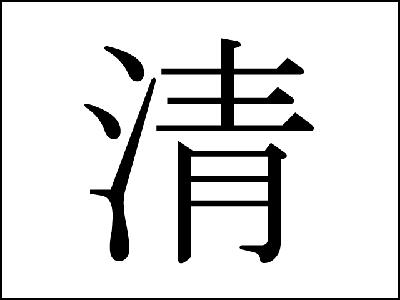【清】 Sei Clean, Pure, Clear
|
清 is a character combining the 氵 three dots water-classifier and 青 ‘blue-green,’ that can first be seen in the Tenbun (Zhuàn Wén) seal script. In reliable Kanji science, the classifier does certainly not always show the leading notion of the character’s meaning, here, however, it originally points to the clearness of water. The basis of its meaning is 青 ‘blue-green,’ which is a color that represents the aesthetic sense of the time when Kanji were created. The lower element of 青 is 丹, which means that there is 丹 ‘cinnabar, vermilion’ (pigment taken from earth and rocks including sulfur) in the mine’ s well for digging cinnabar. Cinnabar of green-bluish color was also collected from such mining wells. The upper element of 青 represents 生 which shows fresh, green, sprouting grass. Chinese characters were created by clerics of the ancient Chinese dynasty of the Yīn (Shāng) dynasty. In contrast to the following Zhōu period, the people of Yīn (Shāng) were a coastal people or were living in areas close to the seas. Even in the present sailors often have tattoos. Especially coastal people often had the custom of tattooing and ritual body painting, which is an expression of the religious view of that period. Such 青 was used as a ‘sacred’ color in rituals. Therefore, the 青 of the so called 青銅器 ‘Seidôki: bronze vessels’ (青銅 ‘Seidô: bronze’) also is no accident. Blue and vermilion were both used for curse exorcism and pacification. It was believed that a force working against curses that exorcizes evil spirits resides in the color used for ritual body painting and festive vessels. As was already emphasized in color theories like that of Von Goethe and Schopenhauer, it is evident that such sacred colors as green-blue and vermilion strike the visual sense intensely. Among them, 青 blue-green was thought of as an especially tranquil color with a pacifying and purifying effect most appropriate in curse exorcism.
- name
- Editoral supervision: Dr. Christoph Schmitz, Researcher of Shirakawa Kanji Science, General and Japanese History of Philosophy and Thought
- hp
- http://nippon-kichi.jp/article_list.do?p=5332













